Fig. 5

Temperature of the circumstellar medium in K at the same time as Figs. 3 and 4. This figure shows the reason for the division in the thin-shell instabilities. At the front of the bowshock as well as between the two stars, the thermalized zone is extremely thin, as a result of effective radiative cooling. Therefore, the shell is subjected to ram-pressure on both sides. In the trailing end (red arrow), the shock is no longer radiative and a relatively thick thermalized zone forms. Hence the zone between contact and termination shock for the LBV wind bubble feels ram-pressure on one side and thermal pressure on the other.
Current usage metrics show cumulative count of Article Views (full-text article views including HTML views, PDF and ePub downloads, according to the available data) and Abstracts Views on Vision4Press platform.
Data correspond to usage on the plateform after 2015. The current usage metrics is available 48-96 hours after online publication and is updated daily on week days.
Initial download of the metrics may take a while.


